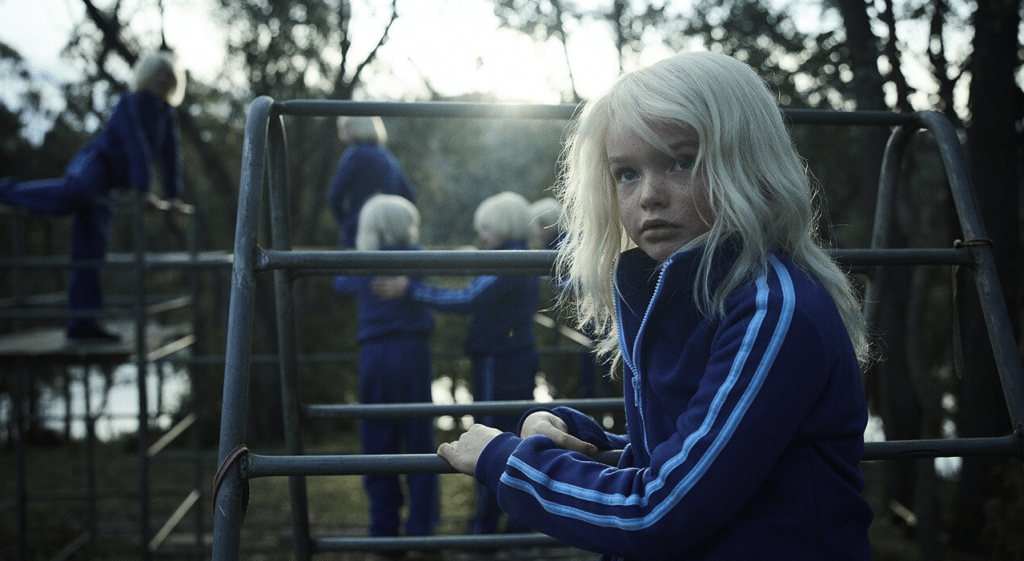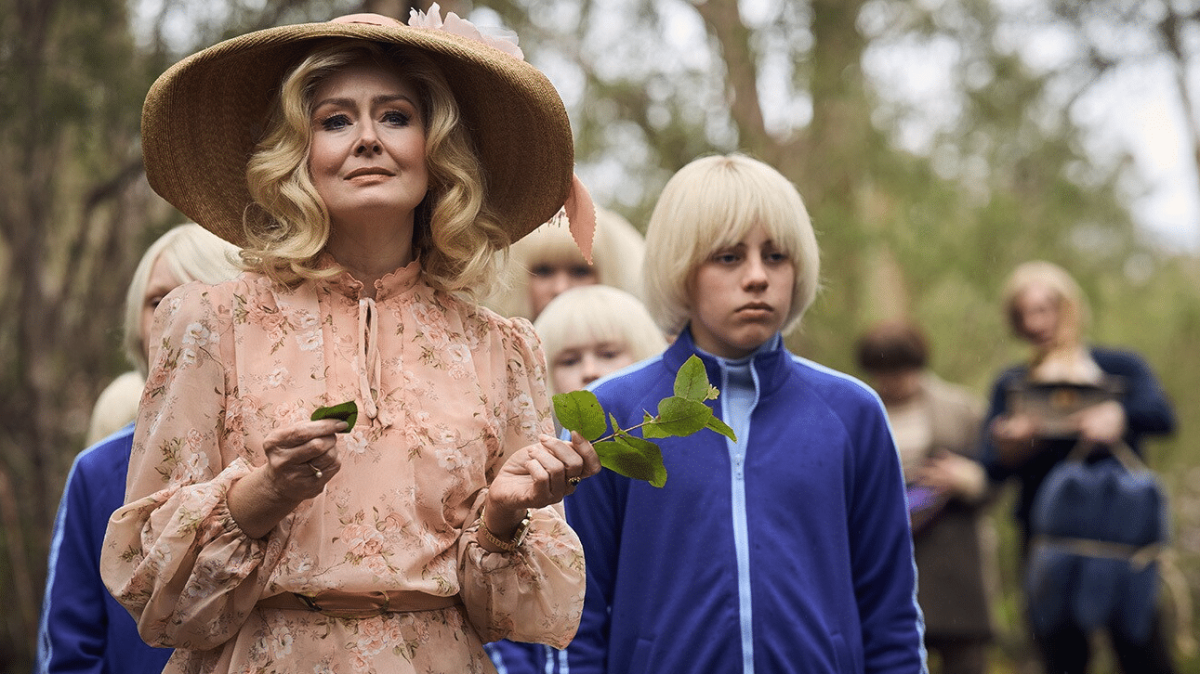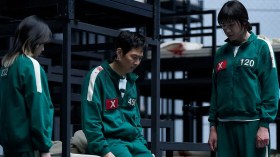Freya (Teresa Palmer) is raising her son Billy (Flynn Wandin) in a small Victorian town where fog floats above a chilly lake, while drowned trees – and secrets – lurk beneath its surface. We first see Freya suspended in these liminal waters, gripping the chain of a diving platform as she tests how long she can hold her breath.
It’s elegant character work: Freya is clearly someone who pushes her own limits to exist in two worlds. Alone with her son and their dog in their secluded and unexpectedly stylish modernist home, she seems calm and playful; but to neighbours, teachers and fellow parents, she’s aloof and distracted.
When Freya learns a child has gone missing, she begins to spiral: frantically checking on Billy, and panicking about a white van she spots lurking by the lake. And as another plotline unfurls in parallel, we learn she’s not just being paranoid. What’s happening in this other story – which follows a cult that abducts and abuses children, led by the sinister Adrienne Beaufort (Miranda Otto) – also informs Freya’s own past.
Adapted from JP Pomare’s crime novel by decorated screenwriters Matt Cameron (Jack Irish, Secret City) and Elise McCredie (Stateless, Ride Like a Girl), The Clearing is intricately, absorbingly plotted, weaving together its two storylines in satisfying ways.
And unlike the slack use of mystery in The Messenger, which left me feeling annoyed to have squandered my good faith in its storytelling, The Clearing tightly controls its pacing and its narrative. It builds intuitive connections between situations and characters, only to plunge them into new and disturbing relationships.
Read: The Messenger returns to depot without attempting to deliver
Disney is keeping a tight lid on this show; only the first two episodes currently streaming were made available to preview, and a new episode will be released each week. I found its careful structure refreshing; most of the enjoyment I got from The Clearing came from simply enjoying its deliberate world-building.
Pointedly based on a true story
While from just two episodes it’s hard to tell how closely The Clearing follows Pomare’s 2019 novel In the Clearing, both the novel and series are unambiguously inspired by a real Australian cult: the Family, led by Anne Hamilton-Byrne. Rosie Jones documented their abuses in her 2016 feature The Family – whose release was accompanied by a nonfiction book by journalist Chris Johnston, co-written with Jones. In 2019 Jones expanded her film into a three-part docuseries, The Cult of the Family.
Read: The Clearing’s Kate Mulvany and Hazem Shammas talk cults and lies
The Clearing renames it the Kindred, and the details of its operations are uncannily close to those of the real-life Family. Adrienne lives luxuriously in a mansion, holding court at weekend gatherings with her adoring, well-heeled followers, and administering the initiation ritual of the title. A ‘clearing’ is a kind of mashup of Scientology audit and shamanic vision quest, fuelled by LSD and recorded on video as kompromat.
Compelling
Otto is compelling in what initially seems like a cartoonish role. Like every character here, Adrienne is ambiguous and unreliable. Is she a shallow narcissist who mashed up self-help, yoga and messianic religion to fuel the adoration she craves? Or is she just a con artist? There’s something wily and grasping about her focus on material wealth.
She manipulates her minions by strategically lavishing and withholding her charismatic attention. Chief among them are Dr Bryce Latham (Guy Pearce), a tweedy physicist whose middle-class respectability is clearly crucial to the public face of the cult; and the deeply unhappy, bowl-haired ‘Aunty Tamsin’ (Kate Mulvany), who terrorises the Kindred’s isolated population of stolen children, starving and beating them into accepting Adrienne as their ‘Mummy’.

Anyone who’s watched the documentaries, or read books and articles about the Family, will recognise its aethetics here – particularly the children in identical old-fashioned outfits, their hair dyed platinum to ‘match’ Anne Hamilton-Byrne’s luxuriant wigs. There’s even a framed black-and-white photo of Miranda Otto sporting the same hairstyle as a notorious portrait of Hamilton-Byrne.
I found this disconcerting, and wondered how the cult’s former child victims – many of whom are still living in Australia – might feel about seeing themselves through this particular looking glass. The fictional Kindred could have been imagined quite differently without compromising the story’s themes of psychological manipulation and trauma … so what does its Family fixation reveal about our cultural hunger for ‘trueness’ in our crime?
Beyond the passive trauma of rural noir
Makeup-free, rugged up in jeans, jumpers and beanies, Palmer’s Freya is a familiar kind of rural noir protagonist – see Elisabeth Moss in Top of the Lake, Anna Torv in The Gloaming, or Kate Winslet in Mare of Easttown. Her physicality works as well for this grimy genre as in her previous roles in A Discovery of Witches and Berlin Syndrome: her grey eyes are wary and haunted, her lips dry and pale. (I’ve often fantasy-cast her as Kristen Stewart’s sister, because both actors have the same elfin features and thousand-yard stare.)
But the parallel narrative to Freya’s story challenges the rural-noir trope of women buffeted by an inescapable, traumatic past. The Clearing is equally about 13-year-old Amy (Julia Savage, Blaze), one of the Kindred’s older children, whom Adrienne is grooming as her ‘special girl’ and chosen heir. Amy in turn becomes drawn to her newly kidnapped ‘sister’, Asha (Lily LaTorre), whose defiance of cult rules and persistent efforts to escape introduce a new moral ambiguity to Amy’s universe.
In rural noir, childhood trauma tends to be cast explicitly as flashback: memories whose intrusiveness only underlines the character’s past disempowerment. The Clearing complicates this trope because Amy’s story has agency. We see Amy’s and Asha’s choices, moment by moment; these kids aren’t just receptacles for other people’s choices.
Jeffrey Walker (The Portable Door, The Commons), who directed the first two episodes, frequently frames Adrienne and Amy together in tight close-up to emphasise the intimacy that both flatters and entraps Amy. (Walker splits directorial duties with Miranda’s sister Gracie Otto (Deadloch, Heartbreak High), whose work we’re yet to see here.)
And this is what makes The Clearing so juicy: it recognises that cults thrive on complicity, not raw domination. And it explores with satisfying ambivalence how traumatised people can delude themselves that they’ve mastered their past.
Rated M
The Clearing is now streaming on Star on Disney+.
Actors:
Teresa Palmer, Guy Pearce, Erroll Shand
Director:
Gracie Otto
Format: Movie
Country: Australia
Release: 24 May 2023





